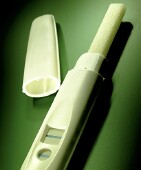- Skip Storing This Everyday Product in the Fridge Door
- Green Tea + B3 Pairing May Boost Brain Health
- Navigating Your Midlife Crisis: Embracing New Possibilities
- City Raccoons Showing Signs of Domestication
- Mapping the Exposome: Science Broadens Focus to Environmental Disease Triggers
- One Week Less on Social Media Linked to Better Mental Health
- Your Brain Changes in Stages as You Age, Study Finds
- Some Suicide Victims Show No Typical Warning Signs, Study Finds
- ByHeart Formula Faces Lawsuits After Babies Sickened With Botulism
- Switch to Vegan Diet Could Cut Your Greenhouse Gas Emissions in Half
U.S. Abortion Rate Drops to Lowest Level Since 1973: Report


The U.S. abortion rate in 2011 was the lowest it has been since 1973, and advances in contraception methods might be part of the reason why, a new report suggests.
The rate in 2011 was 16.9 abortions per 1,000 women aged 15 to 44. That’s far below the rate of 29.3 per 1,000 women in 1981. And it’s just above the lowest rate of 16.3 per 1,000 women in 1973, when abortion became legal in all 50 states following the U.S. Supreme Court’s Roe v. Wade decision.
The rate fell 13 percent between 2008 and 2011, resuming the long-term downward trend that faltered between 2005 and 2008, the study said. Between 2008 and 2011, the number of U.S. abortions dropped to 1.1 million, the Guttmacher Institute researchers said.
The investigators also found that early medication abortion procedures, where drugs such as mifepristone or misoprostol are used to end a pregnancy, are being used in an increasing number of abortions. This method was used in 23 percent (239,400) of all non-hospital abortions in 2011, a rise from 17 percent in 2008. About 59 percent of all known abortion providers offer this method.
“Clearly, the availability of medication abortion does not lead women to have more abortions,” lead study author Rachel Jones said in a Guttmacher news release. “However, it has likely helped women obtain abortion care earlier in pregnancy, as evidenced by a shift toward very early abortions.”
The researchers found that abortion rates fell in all four regions of the country and in all but six states from 2008 to 2011. The sharpest drops were in the Midwest (17 percent) and the West (15 percent), compared with 12 percent in the South and 9 percent in the Northeast.
The few states where there were increases in abortion rates had rates that were lower than the national average to begin with, according to the study that appears in the March issue of the journal Perspectives on Sexual and Reproductive Health.
The number of abortion providers fell 4 percent between 2008 and 2011, and the number of abortion clinics fell by 1 percent.
The researchers noted that the 2008-2011 decline in the abortion rate occurred before tighter limits on abortions were implemented in some states, which means the recent regulations are most likely not the reason for the nationwide decrease.
“With abortion rates falling in almost all states, our study did not find evidence that the national decline in abortions during this period was the result of new state abortion restrictions. We also found no evidence that the decline was linked to a drop in the number of abortion providers during this period,” Jones said.
“Rather, the decline in abortions coincided with a steep national drop in overall pregnancy and birth rates. Contraceptive use improved during this period, as more women and couples were using highly effective long-acting reversible contraceptive methods, such as the IUD. Moreover, the recent recession led many women and couples to want to avoid or delay pregnancy and childbearing,” she added.
Last year, the U.S. Centers for Disease Control and Prevention reported the same trend, although it collects its data differently. The CDC put the 2010 abortion rate at 14.6 abortions per 1,000 women of childbearing age.
More information
The American Academy of Family Physicians has more about abortion.
Source: HealthDay
Copyright © 2025 HealthDay. All rights reserved.










